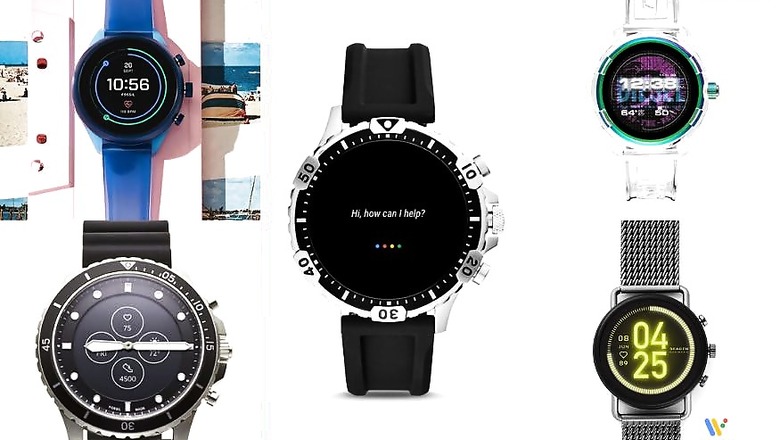
views
Yet another CES, yet more Fossil smartwatches. It really cannot be a Consumer Electronics Show (CES) unless Fossil launches smartwatches by the dozen. Or so it seems. The watchmaker has been at CES 2020 doing what it does best—launch what seem like a million smartwatches. Yet at the end of it all, you are left with that nagging feeling that its all been seen and done before. What really is new? The answer is, to be very honest, not much.
“Fossil Group zooms into the new decade with the debut of its latest collection of smartwatches at the Consumer Electronics Show (CES) in Las Vegas, the world’s premier tech showcase. Innovations in speaker capabilities, battery life, storage capacity, at-a-glance information and more are giving wearers unprecedented choice and control,” says Fossil. Innovations in speaker capabilities? Seriously? THAT is why I should buy a new Fossil smartwatch, or recommend one to a friend? Battery life, at-a-glance information and choice as well as control that the watchmaker speaks of has more to do with the software they run, which in most cases is Google’s Wear OS smartwatch software. And battery life? That’s also got a lot to do with the new Snapdragon Wear 3100 chip.
Let us run through these watches one by one.
First up, the Fossil Gen 5 Garrett HR. This is a Wear OS watch, with a 46mm dial, a touchscreen and a heart rate sensor as well. This will do activity tracking as well as all the Wear OS features such as Google Assistant, notifications, Google Pay and customizable watch faces. There is 8GB of internal storage. Fossil claims around 24 hours of battery life based on how you use it—though my past experience with multiple Fossil smartwatches indicates the real-world battery backup times are significantly lesser than what Fossil claims. Anyway, this can be yours for Rs 22,995 if you choose the stainless steel metal band or the silicone strap.
Then there is the Fossil Hybrid HR Dive, part of Fossil’s “hybrid” push for smartwatches. In this case, “hybrid” is perhaps a better word for “confusing”. What you get is a watch that has what Fossil calls an always-on read out display, but it is not a touchscreen. And neither is the watch face a full display too. The display will show you notifications. The watch will track your heart rate too. Expect this to be priced around $200 (around Rs 14,300 plus taxes).
The Fossil Sport watches get new colourways and there are updates for the Hybrid HR watches too (weren’t they released a few months ago, if memory serves me well?).
Fossil also has the Skagen Falster 3 smartwatches. These are priced at $295 (around Rs 21,000 plus taxes) and are available in the Blue Silicone Mesh, the Two-Tone Leather and the Gunmetal Gauge Mesh options. These run Google’s Wear OS operating system, the new Snapdragon 3100 processor, 1GB RAM and has 8GB storage. This is a 42mm watch with a 1.3-inch OLED display. Oh, and the built-in speaker lets you make and receive calls on the watch itself. Wow. Oh wait, you can hear Google Assistant responses, Google Translate responses and even play music directly on the watch. Dreams really do come true.
Last but not least is the Diesel Fadelite smartwatch. Make what you will of the design though. Fossil describes this as, “This unisex touchscreen smartwatch comes with a transparent strap that’s striking to the eye and exceptionally comfortable on the wrist. It also expands on Diesel’s popular interactive dials with its “Globe” dial that can be rotated to show two additional time zones.” This runs Wear OS and is powered by the Snapdragon 3100 processor. This is priced at $275 (around Rs 19,800 plus taxes) and goes on sale in March.
The point really is, why would you want to buy any of these Fossil smartwatches and confused hybrid watches, when there are significantly better options available already. If fitness and activity tracking is your primary requirement, the Fitbit Versa 2 (around Rs 15,000) is a fantastic option for Android as well as iPhone users. If you want the Google Wear OS, the Mobvoi Ticwatch Pro (around Rs 19,000) is a fantastic option with a a high resolution AMOLED screen and a power saving FSTN LCD screen, long battery life and the full gamut of apps and goodies that come with Wear OS. Outside the Wear OS ecosystem, there are some more great options. There is the Huawei Watch GT2 Sport (around Rs 15,000) which runs a very slick Huawei Lite OS, great battery life thanks to the Kirin A1 processor, a 1.39-inch AMOLED display and the full-fledged fitness tracking capabilities. And if you like the brilliant design and the very classy looks of the Samsung Watch Active2 (around Rs 25,990), you get a gorgeous 1.4-inch Super AMOLED display, a really cool touch bezel and great battery life, to name a few. All of this really puts the new Fossil watches into perspective, and they don’t really come out with an advantage on any of these options already available. Plus, in most cases, they’ll also likely cost more.


















Comments
0 comment